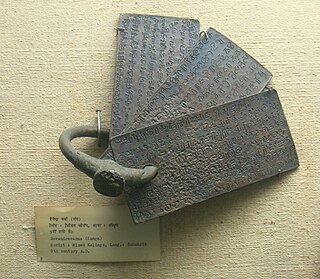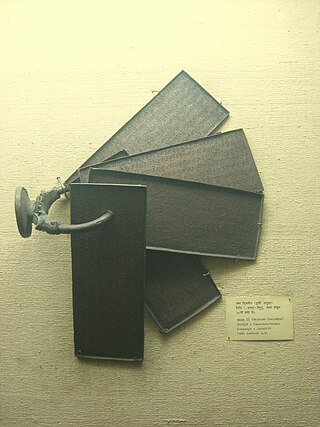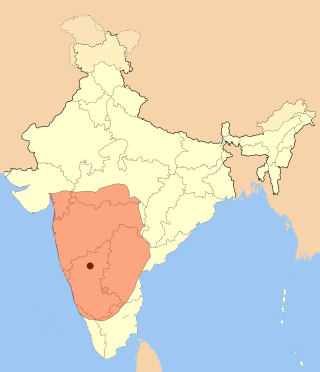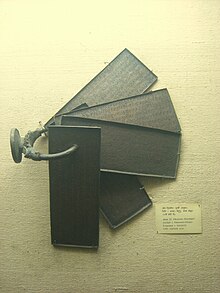
Kannada, previously also known as Canarese, is a Dravidian language spoken predominantly by the people of Karnataka in southwestern India, with minorities in all neighbouring states. It has around 44 million native speakers, and is additionally a second or third language for around 15 million non-native speakers in Karnataka.

The Kannada script is an abugida of the Brahmic family, used to write Kannada, one of the Dravidian languages of South India especially in the state of Karnataka. It is one of the official scripts of the Indian Republic. Kannada script is also widely used for writing Sanskrit texts in Karnataka. Several minor languages, such as Tulu, Konkani, Kodava, Sanketi and Beary, also use alphabets based on the Kannada script. The Kannada and Telugu scripts share very high mutual intellegibility with each other, and are often considered to be regional variants of single script. Other scripts similar to Kannada script are Sinhala script, and Old Peguan script (used in Burma).

The Brahmic scripts, also known as Indic scripts, are a family of abugida writing systems. They are used throughout the Indian subcontinent, Southeast Asia and parts of East Asia. They are descended from the Brahmi script of ancient India and are used by various languages in several language families in South, East and Southeast Asia: Indo-Aryan, Dravidian, Tibeto-Burman, Mongolic, Austroasiatic, Austronesian, and Tai. They were also the source of the dictionary order (gojūon) of Japanese kana.
Telugu script, an abugida from the Brahmic family of scripts, is used to write the Telugu language, a Dravidian language spoken in the Indian states of Andhra Pradesh and Telangana as well as several other neighbouring states. It is one of the official scripts of the Indian Republic. The Telugu script is also widely used for writing Sanskrit texts and to some extent the Gondi language. It gained prominence during the Eastern Chalukyas also known as Vengi Chalukya era. It shares extensive similarities with the Kannada script, as both of them evolved from the Bhattiprolu and Kadamba scripts of the Brahmi family. In 2008, the Telugu language was given the status of a Classical Language of India, in recognition of its rich history and heritage.

The Kadambas were an ancient royal family of Karnataka, India, that ruled northern Karnataka and the Konkan from Banavasi in present-day Uttara Kannada district. The kingdom was founded by Mayurasharma in c. 345, and at later times showed the potential of developing into imperial proportions. An indication of their imperial ambitions is provided by the titles and epithets assumed by its rulers, and the marital relations they kept with other kingdoms and empires, such as the Vakatakas and Guptas of northern India. Mayurasharma defeated the armies of the Pallavas of Kanchi possibly with the help of some native tribes and claimed sovereignty. The Kadamba power reached its peak during the rule of Kakusthavarma.

Western Ganga was an important ruling dynasty of ancient Karnataka in India which lasted from about 350 to 1000 CE. They are known as "Western Gangas" to distinguish them from the Eastern Gangas who in later centuries ruled over Kalinga. The general belief is that the Western Gangas began their rule during a time when multiple native clans asserted their freedom due to the weakening of the Pallava empire in South India, a geo-political event sometimes attributed to the southern conquests of Samudra Gupta. The Western Ganga sovereignty lasted from about 350 to 550 CE, initially ruling from Kolar and later, moving their capital to Talakadu on the banks of the Kaveri River in modern Mysore district.

Since the Iron Age in India, the native languages of the Indian subcontinent are divided into various language families, of which the Indo-Aryan and the Dravidian are the most widely spoken. There are also many languages belonging to unrelated language families such as Munda and Tibeto-Burman, spoken by smaller groups.

Halmidi is a small village in the Hassan district of Karnataka state, India, near the temple town of Belur. Halmidi is best known as the place where the oldest known inscription exclusively in Kannada language, the Halmidi inscription, was discovered. Anterior to this, many inscriptions with Kannada words have been discovered, such as Brahmagiri edict of 230 BCE of Emperor Ashoka. However, this is the first full length inscription in Kannada. This inscription is generally known as the Halmidi inscription and consists of sixteen lines carved on a sandstone slab. It has been dated to 450 CE and demonstrates that Kannada was used as a language of administration at that time. The inscription is in primitive Kannada with distinctive characteristics attributed to those of Proto-Kannada and uses Kannada script similar to Brahmi characters.

Eastern Chalukyas, also known as the Chalukyas of Vengi, were a dynasty that ruled parts of South India between the 7th and 12th centuries. They started out as governors of the Chalukyas of Badami in the Deccan region. Subsequently, they became a sovereign power, and ruled the Vengi region of present-day Andhra Pradesh until c. 1001 CE. They continued ruling the region as feudatories of the Medieval Cholas until 1189 CE.
Durvinita is seen as the most successful ruler of the Western Ganga dynasty. Son of the previous ruler, Avinita, Durvinita's accession to the throne was disputed by his brother, who had gained the support of the Pallavas and Kadambas. There are Nallala and Kadagattur inscriptions that refer to this dispute. However, Durvinita managed to grab the throne by virtue of his valour.

The History of Karnataka goes back several millennia. Several great empires and dynasties have ruled over Karnataka and have contributed greatly to the history, culture and development of Karnataka as well as the entire Indian subcontinent. The Chindaka Nagas of central India Gangas, Rashtrakutas of Manyakheta, Chalukyas of Vengi, Yadava Dynasty of Devagiri were all of Kannada origin who later took to encouraging local languages.

The Pallava script or Pallava Grantha is a Brahmic script named after the Pallava dynasty of Southern India (Tamilakam) and is attested to since the 4th century CE. In India, the Pallava script evolved from Tamil-Brahmi. The Grantha script originated from the Pallava script. Pallava also spread to Southeast Asia and evolved into local scripts such as Balinese, Baybayin, Javanese, Kawi, Khmer, Lanna, Lao, Mon–Burmese, New Tai Lue, Sundanese, and Thai.

The earliest undisputed deciphered epigraphy found in the Indian subcontinent are the Edicts of Ashoka of the 3rd century BCE, in the Brahmi script.

The political history of medieval Karnataka spans the 4th to the 16th centuries in Karnataka region of India. Previously foreign empires held sway over the region, and the nucleus of power was outside modern Karnataka. The medieval era can be broadly divided into several periods: The earliest native kingdoms and imperialism; the successful domination of the Gangetic plains in northern India and rivalry with the empires of Tamilakam over the Vengi region; and the domination of the southern Deccan and consolidation against Muslim invasion. The origins of the rise of the Karnataka region as an independent power date back to the fourth-century birth of the Kadamba Dynasty of Banavasi, the earliest of the native rulers to conduct administration in the native language of Kannada in addition to the official Sanskrit. This is the historical starting point in studying the development of the region as an enduring geopolitical entity and of Kannada as an important regional language.

The Kalinga script or Southern Nagari is a Brahmic script used in the region of what is now modern-day Odisha, India and was primarily used to write Odia language in the inscriptions of the kingdom of Kalinga which was under the reign of early Eastern Ganga dynasty. By the 12th century, with the defeat of the Somavamshi dynasty by the Eastern Ganga monarch Anantavarman Chodaganga and the subsequent reunification of the Trikalinga(the three regions of ancient Odra- Kalinga, Utkala and Dakshina Koshala) region, the Kalinga script got replaced by the Siddhaṃ script-derived Proto-Oriya script which became the ancestor of the modern Odia script.
Old Kannada or Halegannada is the Kannada language which transformed from Purvada halegannada or Pre-old Kannada during the reign of the Kadambas of Banavasi.

Talagunda is a village in the Shikaripura taluk of Shivamogga district in the state of Karnataka, India. Many inscriptions found here have provided insights into the rise of the Kadamba Dynasty.

The Telugu–Kannada script was a writing system used in Southern India. Despite some significant differences, the scripts used for the Telugu and Kannada languages remain quite similar and highly mutually intelligible. Satavahanas and Chalukyas influenced the similarities between Telugu and Kannada scripts.

The Chalukya dynasty was a Classical Indian dynasty that ruled large parts of southern and central India between the 6th and the 12th centuries. During this period, they ruled as three related yet individual dynasties. The earliest dynasty, known as the "Badami Chalukyas", ruled from Vatapi from the middle of the 6th century. The Badami Chalukyas began to assert their independence at the decline of the Kadamba kingdom of Banavasi and rapidly rose to prominence during the reign of Pulakeshin II. After the death of Pulakeshin II, the Eastern Chalukyas became an independent kingdom in the eastern Deccan. They ruled from Vengi until about the 11th century. In the western Deccan, the rise of the Rashtrakutas in the middle of the 8th century eclipsed the Chalukyas of Badami before being revived by their descendants, the Western Chalukyas, in the late 10th century. These Western Chalukyas ruled from Kalyani until the end of the 12th century.

About 25,000 inscriptions found in Karnataka and nearby states belong to historic Kannada rulers, including the Kadambas, the Western Ganga Dynasty, the Rashtrakuta, the Chalukya, the Hoysala and the Vijayanagara Empire. Many inscriptions related to Jainism have been unearthed. The inscriptions found are generally on stone (Shilashasana) or copper plates (Tamarashasana). These Kannada inscriptions are found on historical hero stones, coins, temple walls, pillars, tablets and rock edicts. They have contributed towards Kannada literature and helped to classify the eras of Proto Kannada, Pre Old Kannada, Old Kannada, Middle Kannada and New Kannada. Inscriptions depict the culture, tradition and prosperity of their era. The literature of Ramayana and Mahabharata are transferred through the generations by these inscriptions. The Hazara Rama Temple and Aranmula Parthasarathy Temple are the best examples of temples associated with Kannada inscriptions.





















